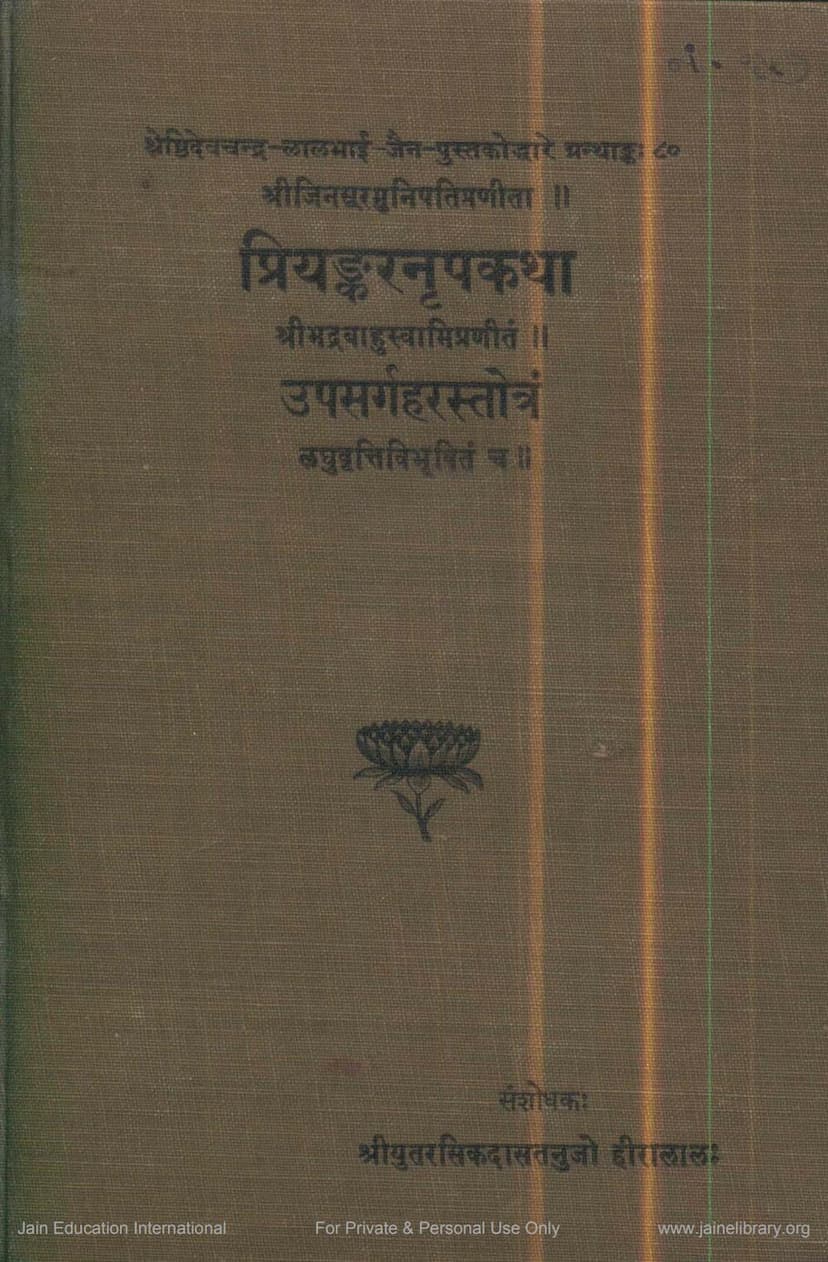Priyankarnrupkatha
Added to library: September 2, 2025

Summary
Here is a comprehensive summary of the Jain text "Priyankar-nṛpa-kathā" by Hiralal R. Kapadia, published by the Devchand Lalbhai Pustakoddhar Fund:
Title: Priyankara-nṛpa-kathā (The Tale of King Priyankara) Author: Muni Shri Jinasūri Accompanying Text: Upasargaharahastotra (Hymn for the Removal of Calamities) by Śruta-kevalin Shri Bhadrabāhu Svāmin, with a commentary by Dvij Shri Pārśvadeva Gaṇi. Editor: Prof. Hīrālāl Rasikdās Kāpaḍiyā, M.A. Publisher: Devchand Lalbhai Jain Pustakoddhar Fund Publication Date: Vikram Samvat 1988 / AD 1932 / Vir Samvat 2458 Number of Copies: 1250 Language: Primarily Prakrit and Old Gujarati, with Sanskrit introductions and commentaries.
Overview:
This volume, numbered 80 in the Devchand Lalbhai Jain Pustakoddhar Fund series, presents a critical edition of "Priyankar-nṛpa-kathā," a significant Jain narrative work attributed to Muni Shri Jinasūri. It is published alongside the highly revered "Upasargaharahastotra" by Bhadrabāhu Svāmin, a scripture known for its efficacy in removing obstacles. The editor, Prof. Hīrālāl Kāpaḍiyā, has diligently worked to make this text accessible by including sub-stories, a Sanskrit introduction, and detailed indexes.
Key Components and Content:
-
Priyankara-nṛpa-kathā (The Tale of King Priyankara):
- Narrative: The story centers around King Priyankara, highlighting his virtuous life, challenges, and eventual success through devotion and adherence to Dharma. The narrative begins in the city of Ashokpur in Magadha, ruled by King Ashokchandra, his queen Ashokmala, and their three sons. The story details the wedding of Arisura, the construction of a palace, the creation of a magnificent necklace called 'Devavallabh', and the subsequent disappearance of this necklace, leading to mystery and investigation.
- Themes: The tale emphasizes the importance of righteousness, moral conduct, the consequences of one's actions (karma), the power of devotion (especially to Lord Pārśvanātha), the unpredictability of fortune, and the societal impact of wealth and poverty. It explores themes of fate, virtue, the challenges posed by unethical individuals (like cheaters and envious people), and the ultimate triumph of righteousness.
- Sub-stories and Digressions: The narrative is rich with embedded stories and moral teachings, including:
- The story of Pasadatta, a wealthy merchant who becomes impoverished but finds treasure through his virtuous wife and adherence to Dharma.
- The story of his son, Priyankara, who demonstrates great wisdom and devotion, eventually becoming king.
- The tale of Dhanadatta, a wealthy merchant whose new house is plagued by a malevolent spirit, which is eventually overcome by Priyankara's devotion.
- The story of the Brahmin's daughter and her rescue, showcasing Priyankara's compassion.
- The incident involving the envious minister and the divine intervention.
- The detailed description of social customs, rituals, culinary practices, and the classification of sons and wives.
- Language and Style: The text is noted for its blend of Prakrit and Old Gujarati, reflecting the language of the time. It uses vivid descriptions, moral exemplars, and allegorical elements to convey its teachings.
- Author Attribution: The preface and the text itself suggest that the author is Muni Shri Jinasūri, a disciple of Vishalaraj Sūriśvara. The introduction by Prof. Kāpaḍiyā provides scholarly analysis on the authorship and historical context, comparing it with other works.
-
Upasargaharahastotra (Hymn for the Removal of Calamities):
- Authorship: Universally attributed to the great Jain scholar Śruta-kevalin Shri Bhadrabāhu Svāmin.
- Significance: This hymn is highly revered in Jainism for its power to remove afflictions, overcome dangers, and bestow blessings. It is often recited with mantras and rituals.
- Commentary: The included commentary by Dvij Shri Pārśvadeva Gaṇi is crucial for understanding the scriptural, mystical, and ritualistic aspects of the hymn. It delves into the meanings of the verses, the associated mantras, yantras (mystical diagrams), and the specific deities (like Dharanendra and Padmavati) associated with its practice. The commentary provides intricate details on their use for various purposes, such as protection from spirits, diseases, and granting wealth and prosperity.
- Structure: While traditionally believed to be a short hymn, the commentary discusses its various forms and the presence of additional verses.
-
Editor's Contribution:
- Prof. Hīrālāl R. Kāpaḍiyā has provided a meticulous scholarly edition.
- His introduction offers a detailed analysis of the text's literary and historical significance, authorship, and linguistic features.
- He has compiled valuable appendices, including:
- Antar-kathā (Sub-stories): Narratives embedded within or related to the main story, such as the tale of Ranka Shresthi and the story of Kamal Shresthi, illustrating moral principles.
- Alphabetical Index of Verses: A comprehensive list of all verses from the "Priyankara-nṛpa-kathā" with their page numbers.
- Index of Specific Names: An alphabetical listing of cities, individuals, and other significant terms mentioned in the text.
Overall Impression:
"Priyankara-nṛpa-kathā," along with the "Upasargaharahastotra" and its extensive commentary, represents a valuable contribution to Jain literature. It is a rich tapestry of moral instruction, devotional practice, and cultural insights from medieval India. The scholarly work of Prof. Kāpaḍiyā ensures its accessibility to a wider audience interested in Jain traditions, philosophy, and historical narratives. The devotional efficacy of the accompanying hymn, coupled with the detailed explanations of its ritualistic applications, makes this volume particularly significant for practitioners.